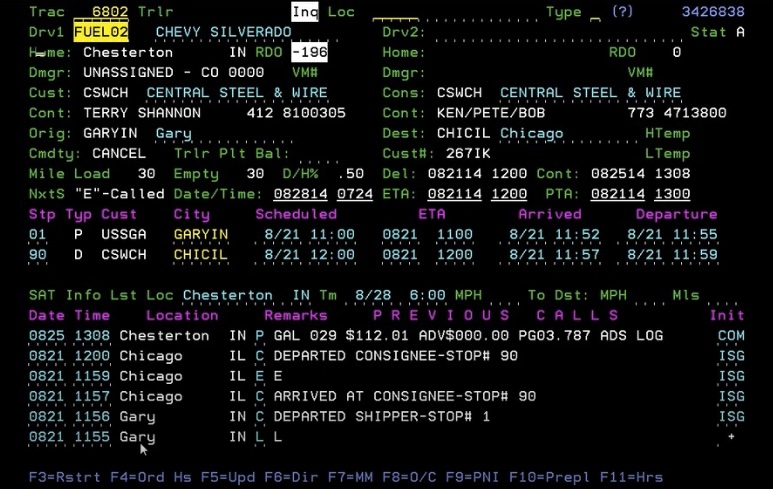Introduction
The AS400 programming language, often hailed as a cornerstone in the world of legacy computing, has been a subject of fascination and utility for many programmers and organizations worldwide. The enduring relevance of the AS400 system, in conjunction with its unique programming language, makes it an intriguing subject for both new and experienced programmers.
Key Characteristics of the AS400 Programming Language
Understanding the AS400 programming language necessitates delving into its origins. Initially developed by IBM, the AS400, also recognized as IBM iSeries, emerged as a midrange server tailored for small businesses and departments within large enterprises. The AS400 programming language, primarily RPG (Report Program Generator) and CL (Control Language), was crafted to be resilient and adaptable, addressing various business requirements.
RPG (Report Program Generator)
RPG stands as a high-level programming language predominantly employed for business applications within the AS400 environment. It offers several iterations, each with its own set of features and capabilities:
| RPG Version | Description |
|---|---|
| RPG II | An early version of RPG, known for its simplicity and ease of use. |
| RPG III | Enhanced version introducing more advanced features such as arrays and subroutines. |
| RPG IV (ILE RPG) | Latest version incorporating modern programming constructs and support for ILE (Integrated Language Environment). |
CL (Control Language)
CL, or Control Language, is utilized for administrative tasks on the AS400 system. It encompasses commands specifically tailored for file management, job control, and other system-level operations.
DB2 Database Integration
The AS400 system is renowned for its seamless integration with the DB2 database management system. This integration allows leveraging SQL (Structured Query Language) for efficient database management within AS400 applications. Key aspects of DB2 integration include:
- SQL Support: AS400 applications can seamlessly execute SQL queries, facilitating efficient data retrieval and manipulation;
- Relational Database Management: DB2 integration enables the storage and management of data in a relational database format, ensuring data integrity and flexibility.
Compatibility and Longevity
One of the hallmark features of the AS400 platform is its remarkable backward compatibility. It sustains applications developed decades ago, a testament to its longevity and robustness. Moreover, the AS400 ecosystem continues to evolve, integrating modern technologies and programming languages to meet contemporary business needs.
Real-World Applications and Benefits

The AS400 programming language stands as a stalwart in the realm of business computing, finding extensive applications across a myriad of sectors, including finance, manufacturing, healthcare, and beyond. Its robustness, reliability, and security features make it particularly well-suited for applications where high uptime and stringent data integrity are non-negotiable. Let’s delve into the real-world applications and the manifold benefits that the AS400 programming language offers:
Finance Sector
In the finance sector, where data security and reliability are paramount, the AS400 programming language plays a pivotal role in powering critical financial operations. Financial institutions rely on AS400 systems for a multitude of tasks, including:
- Transaction Processing: The robustness of AS400 ensures seamless and secure transaction processing, facilitating smooth banking operations without compromising on the confidentiality and integrity of financial data;
- Regulatory Compliance: AS400’s stringent security features aid financial institutions in adhering to regulatory compliance standards such as PCI DSS, ensuring that sensitive financial data is protected against unauthorized access or breaches.
Manufacturing Industry
Manufacturing companies leverage the AS400 programming language to optimize their operations and enhance productivity. Key applications in this sector include:
- Inventory Management: AS400 systems streamline inventory management processes, enabling efficient tracking of raw materials, work-in-progress, and finished goods. This, in turn, helps in minimizing stockouts, reducing inventory holding costs, and optimizing production schedules;
- Supply Chain Optimization: AS400’s integration capabilities facilitate seamless communication and coordination across the supply chain, enabling manufacturers to optimize production schedules, reduce lead times, and enhance overall operational efficiency.
Healthcare Sector
In the healthcare sector, where patient data security and privacy are of utmost importance, AS400 programming language finds extensive usage in:
- Electronic Health Records (EHR) Management: AS400 systems provide a secure platform for storing and managing electronic health records, ensuring the confidentiality and integrity of patient information. This enables healthcare providers to deliver quality care while complying with regulatory requirements such as HIPAA;
- Medical Billing and Claims Processing: AS400’s efficiency in handling complex business processes makes it an ideal choice for healthcare organizations to streamline medical billing and claims processing workflows. This results in improved revenue cycle management, reduced administrative overheads, and enhanced patient satisfaction.
The Learning Curve and Resources

For newcomers venturing into the realm of the AS400 programming language, the initial encounter might seem daunting. However, there exists a plethora of resources and vibrant communities dedicated to AS400 programming, providing a wealth of tutorials, forums, documentation, and practical guidance. Let’s explore the key learning steps and resources available to aid in mastering the AS400 programming language:
RPG (Report Program Generator)
RPG stands as the cornerstone of AS400 programming, primarily utilized for developing business applications. To embark on the journey of learning RPG, newcomers should familiarize themselves with its various versions and syntax conventions. Key resources for learning RPG include:
- Online tutorials: Websites such as IBM DeveloperWorks and RPGPGM Magazine offer comprehensive tutorials covering RPG fundamentals, syntax, and best practices;
- Books: Publications like “Programming in RPG IV” by Bryan Meyers provide in-depth insights into RPG programming concepts and techniques;
- Online communities: Participating in online forums such as RPG Next Gen allows newcomers to seek guidance, share experiences, and learn from seasoned RPG developers.
CL (Control Language)
CL serves as the command language for the AS400 system, essential for executing administrative tasks and managing system resources. Resources for learning CL include:
- IBM Documentation: IBM’s official documentation provides detailed guides and reference materials covering CL commands, syntax, and usage scenarios;
- Online courses: Platforms like Udemy and Coursera offer courses specifically tailored for learning CL, providing hands-on exercises and practical examples to reinforce learning;
- User groups: Joining AS400 user groups and forums enables newcomers to engage with experienced CL programmers, seek advice, and explore real-world applications of CL scripting.
Navigating the AS400 Environment
Navigating the AS400 environment effectively is crucial for mastering AS400 programming. Key aspects to focus on include:
- Terminal Emulation: Understanding terminal emulation software, such as IBM’s Client Access or TN5250, is essential for accessing and interacting with AS400 systems remotely;
- Basic Commands: Familiarizing oneself with basic AS400 commands for navigating the system, managing libraries, and executing programs is fundamental;
- Integrated Development Environment (IDE): Exploring AS400’s integrated development environment, such as IBM Rational Developer for i (RDi), provides newcomers with tools for efficient code development, debugging, and deployment.
Grasping Database Management with DB2
DB2 integration is integral to AS400 programming, enabling efficient database management and data manipulation. Resources for mastering DB2 integration include:
- DB2 Documentation: IBM’s documentation on DB2 for i provides comprehensive guides and tutorials on database design, SQL querying, and performance optimization;
- Online Courses: Platforms like LinkedIn Learning and Pluralsight offer courses specifically focused on DB2 integration within the AS400 environment, covering topics ranging from data modeling to advanced SQL techniques;
- Practical Projects: Engaging in practical projects that involve database management tasks, such as designing and implementing a customer relationship management (CRM) system or inventory tracking application, allows newcomers to apply theoretical knowledge in real-world scenarios and reinforce learning.
AS400 Programming Language in Today’s Tech Landscape
Despite the emergence of new technologies, AS400’s adaptability, integration capabilities, and IBM’s commitment to updates have sustained its position as a viable platform for modern business computing. Let’s delve into the key aspects that highlight AS400’s relevance in today’s tech landscape:
Integration with Web Services
AS400 systems have evolved to seamlessly interact with web services, facilitating integration with modern web technologies. This integration serves as a bridge between legacy AS400 applications and the burgeoning world of web-based services, enabling organizations to leverage existing AS400 infrastructure while incorporating contemporary web functionalities. Key features of AS400’s integration with web services include:
- SOAP and RESTful APIs: AS400 supports both SOAP (Simple Object Access Protocol) and REST (Representational State Transfer) APIs, allowing for standardized communication with web services;
- Data Exchange: AS400 applications can exchange data with web services in real-time, enabling efficient integration with external systems and services;
- Security: AS400’s robust security features ensure secure communication with web services, safeguarding sensitive data and protecting against potential threats.
Open Source Software Support
AS400 has embraced the trend of open-source software, providing enhanced support for popular open-source languages and tools. This shift towards open-source ecosystems enables AS400 developers to leverage a wider range of resources and libraries, fostering innovation and collaboration within the AS400 community. Key aspects of AS400’s support for open-source software include:
- Language Support: AS400 now supports open-source languages such as Python, PHP, and Node.js, expanding the developer toolkit and enabling the development of diverse applications;
- Tooling: Integration with open-source development tools such as Git, Jenkins, and Docker enhances AS400’s development workflow, facilitating version control, continuous integration, and containerization;
- Community Engagement: AS400’s embrace of open-source software encourages community engagement and collaboration, fostering the exchange of knowledge, best practices, and contributions within the AS400 ecosystem.
Cloud Compatibility
AS400 has adapted to the shift towards cloud computing, ensuring compatibility with cloud environments to provide organizations with flexibility, scalability, and cost-effectiveness. By embracing cloud technologies, AS400 enables organizations to modernize their infrastructure, leverage cloud-based services, and optimize resource utilization. Key features of AS400’s cloud compatibility include:
- Virtualization: AS400 systems can be virtualized on cloud platforms such as IBM Cloud, AWS, and Azure, allowing for dynamic resource allocation and scalability;
- Platform as a Service (PaaS): AS400 PaaS offerings provide organizations with managed AS400 environments in the cloud, simplifying deployment, management, and maintenance tasks;
- Hybrid Cloud Integration: AS400 supports hybrid cloud architectures, enabling seamless integration between on-premises AS400 systems and cloud-based services, ensuring interoperability and data consistency.
Conclusion
The AS400 programming language stands as a testament to the enduring nature of well-designed technology. Its continued relevance in a rapidly evolving tech landscape is a story of adaptability, reliability, and the persistent value of legacy systems in modern computing. Whether you’re a seasoned programmer or a curious newcomer, exploring the depths of AS400 programming is a journey worth taking.
FAQ
Yes, especially in industries that rely on legacy systems, like finance and manufacturing.
Absolutely. AS400 systems can work alongside languages like Java and Python.
While unique, numerous resources and a supportive community make learning AS400 programming feasible.
With its adaptability to cloud environments and ongoing IBM support, AS400 remains a viable and evolving platform.
